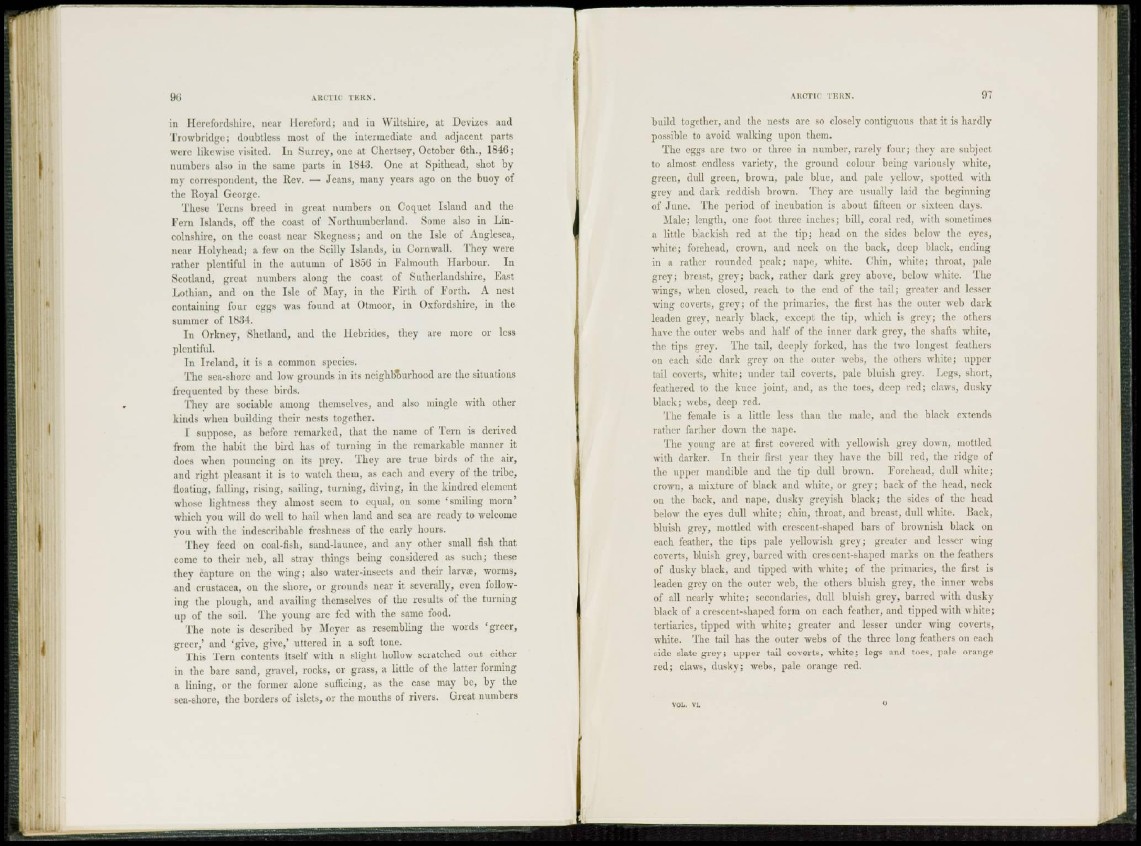
ARCTIC TERN.
in Herefordshire, near Hereford; and in Wiltshire, at Devizes and
Trowbridge; doubtless most of the intermediate and adjacent parts
were likewise visited. In Surrey, one at Chertsey, October 6th., 1846;
numbers also in the same parts in 1843. One at Spithead, shot by
my correspondent, the Rev. — Jeans, many years ago on the buoy of
the Royal George.
These Terns breed in great numbers on Coquet Island and the
Fern Islands, off the coast of Northumberland. Some also in Lincolnshire,
on the coast near Skegness; and on the Isle of Auglesea,
near Holyhead; a few on the Sciily Islands, in Cornwall. They were
rather plentiful in the autumn of 1856 in Falmouth Harbour. In
Scotland, great numbers along the coast of Sutherlandshire, East
Lothian, and on the Isle of May, in the F i r t h of Forth. A nest
containing four eggs was found at Otmoor, in Oxfordshire, in the
summer of 1834.
I n Orkney, Shetland, and the Hebrides, they are more or less
plentiful.
In Ireland, it is a common species.
The sea-shore and low grounds in its neighbourhood are the situations
frequented by these birds.
They are sociable among themselves, and also mingle with other
kinds when building their nests together.
I suppose, as before remarked, that the name of Tern is derived
from the habit the bird has of turning in the remarkable manner it
d o e s when pouncing on its prey. They are true birds of the air,
and right pleasant it is to watch them, as each and every of the tribe,
floating, falling, rising, sailing, turning, diving, in the kindred element
whose lightness they almost seem to equal, on some 'smiling morn*
which you will do well to hail when land and sea are ready to welcome
you with the indescribable freshness of the early hours.
They feed on coal-fish, saud-launce, and any other small fish that
come to their neb, all stray things being considered as such; these
they capture on the wing; also water-insects and their larva?, worms,
and Crustacea, on the shore, or grounds near it severally, even following
the plough, and availing themselves of the results of the turning
up of the soil. The young arc fed with the same food.
The note is described by Meyer as resembling the words 'grcer,
greer,' and ' g i v e , give,' uttered in a soft tone.
This Tern contents itself with a slight hollow scratched out either
in the bare sand, gravel, rocks, or grass, a little of the latter forming
a lining, or the former alone sufficing, as the case may b e , by t he
sea-shore, the borders of islets, or the mouths of rivers. Great numbers
ARCTIC TERN. 91
build together, and the nests are so closely contiguous that it is hardly
possible to avoid walking upon them.
The eggs are two or three in number, rarely four; they are subject
to almost endless variety, the ground colour being variously white,
green, dull green, brown, pale blue, and pale yellow, spotted with
grey and dark reddish brown. They are usually laid the beginning
of June. The period of incubation is about fifteen or sixteen days.
Male; length, one foot three inches; hill, coral red, with sometimes
a little blackish red at the t i p ; head on the sides below the eyes,
white; forehead, crown, and neck on the back, deep black, ending
in a rather rounded peak; nape, white. Chin, white; throat, pale
grey; breast, grey; back, rather dark grey above, below white. The
wings, when closed, reach to the end of the tail; greater and lesser
wing coverts, grey; of the primaries, the first has t he outer web dark
leaden grey, nearly black, except the tip, which is grey; the others
have the outer webs and half of the inner dart grey, the shafts white,
the tips grey. The tail, deeply forked, has the two longest feathers
on each side dark grey on the outer webs, the others white; upper
tail coverts, white; under tail coverts, pale bluish grey. Legs, short,
feathered to the knee joint, and, as the toes, deep red; claws, dusky
black; webs, deep red.
The female is a little less than the male, and the black extends
rather farther down the nape.
The young are at first covered with yellowish grey down, mottled
with darker. In their first year they have the hill red, the ridge of
the upper mandible and the t ip dull brown. Forehead, dull white;
crown, a mixture of black and white, or g r e v ; back of the head, neck
on the back, and nape, dusky greyish black; the sides of the head
below the eyes dull white; chin, throat, and breast, didl white. Back,
bluish grey, mottled with crescent-shaped bars of brownish black on
each feather, the tips pale yellowish grey; greater and lesser wing
coverts, bluish grey, barred with crescent-shaped marks on the feathers
of dusky black, and tipped with white; of the primaries, the first is
leaden grey on the outer web, the others bluish grey, the inner webs
of all nearly white; secondaries, dull bluish grey, barred with dusky
black of a crescent-shaped form on each feather, and tipped with white;
tcrtiarics, tipped with white; greater and lesser under wing coverts,
white. The tail has t he outer webs of the three long feathers on each
side slate grey; upper tail coverts, white; legs and toes, pale orange
red; claws, dusky; webs, pale orange red.
VOL. VI.